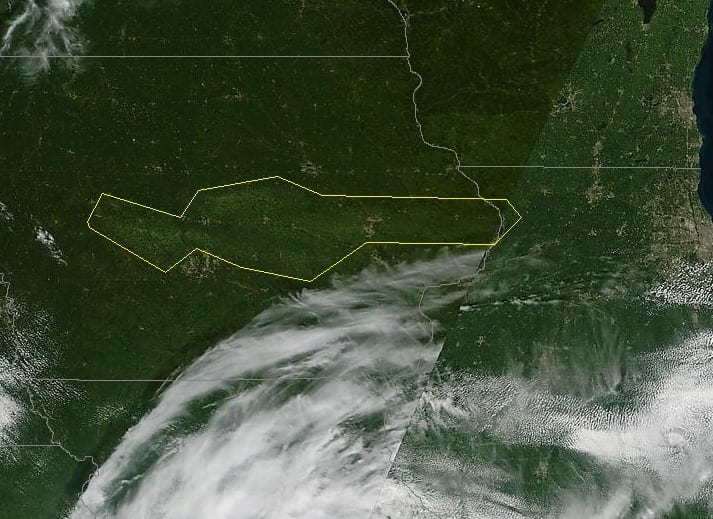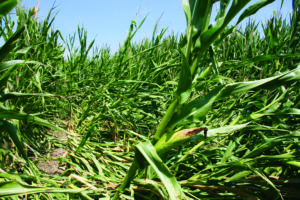
A satellite captures the damage caused by the August 10 derecho that blew across the Corn Belt.
Heavy winds experienced in the August 10 derecho dramatically damaged crops across central Iowa, northern Illinois and other portions of the Corn Belt. In the aftermath, the question is raised: How do I deal with my damaged corn?
Some fields may not be harvested, some will be chopped for silage and some will be harvested for grain. Decisions will be made based on the development stage of the corn, most between R3 (milk) and R5 (dent).
Expectations for lodged corn

Corn that is bent may recover, but kinked corn can be harvested for silage.
Iowa State University explored options for three stages of lodged corn:
- Plants that are only slightly root-lodged or leaning at a 45° or greater angle. The ability of corn to recover from lodging at R4 to R5 is much less likely than if plants were lodged just before or after tasseling. Availability of moisture and severity of root system damage will both play a role in the extent of yield loss.
- Plants that are pinched over but not yet wilted, broken above the ear, or severely root-lodged (<45° angle) and laying on or near the ground. Kinks in stalks restrict movement of resources within the plant and flat plants that remain rooted are not intercepting the amount of sunlight needed for normal grain fill. Significant root damage along with continued dry conditions will compromise nutrient and water uptake, leading to decreased yield. Plants with broken stalks above the ear will continue to produce photosynthates using intact leaves, but the available resources to fill grain will be greatly limited. Stress may cause premature death of some plants while others will mature at a much slower pace.
- Plants that are broken off below the ear and are now wilting or dead above the breakage site. Plants in this condition can no longer add dry matter to the grain, so test weight will be low. The ability to store grain killed in the dough stage is extremely limited, if at all possible. At early dent stage, yield loss is likely more than 40 percent, with test weight and storage capability remaining very low. The best use is silage, if a use for this amount of silage can be found.
Nutrient content in wind-damaged corn
Nutrients such as nitrogen (N), phosphorus (P) and potassium (K) remaining in damaged fields may be different than with normal harvest, so adjustments can be made for future fertilizer or manure applications.
Plant dry matter and nutrient content increase as reproductive stages and grain fill progress. For plant harvest at corn stages not normal for silage or grazing, P and K concentration estimates can be adjusted based on the growth stage. However, estimating amounts of P and K remaining or removed will be difficult and uncertain with partial plant harvest or grazing.
If corn plants are broken off and die, and plant parts are not removed or grazed, then dry matter yield and P and K concentrations can be approximated based on the growth stage when kills; and the P and K amounts remaining in the field will be available for future crops.
Nitrogen remaining in non-harvested plant material will cycle through the soil system. If there is no plant material harvested, then there is more potential for increased amounts of N to be available to next year’s corn crop. However, estimation should not be taken into account until the spring of 2021 as time is needed for N mineralization and rapid change in inorganic-N (specifically nitrate) can occur from late summer to next spring.
For more information on this topic, please visit the Iowa State University Extension and Outreach Integrated Crop Management website.
Harvesting damaged corn

The National Weather Service Radar showing how the derecho moved across Iowa and surrounding states on August 10, 2020.
Harvest dead or dying corn as soon as possible and treat with inoculants to aid fermentation and help inhibit yeasts and molds.
Harvest damaged corn carefully. Chop slowly and keep cutting knives sharp. Cones and reels help pull in kinked corn. Chain-driven chopper heads pick up downed corn better than teeth or kemper cutters. Proper packing speed and density are critical regardless of silage stage at harvest. Removing oxygen from silage is also important to fermentation to inhibit the growth of yeasts and molds.
Flattened corn should be disked and plowed to eliminate residue and reduce volunteer corn.
Consult your AgVenture Yield Specialist for more information or specific advisement on these topics.
